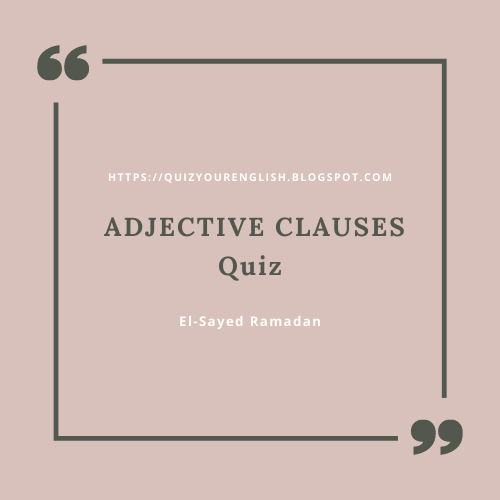ADJECTIVE CLAUSES
Adjective Clauses
Adjective clauses, also known as relative clauses, are essential elements of the English language that can help to add
detail and depth to your writing. They are often used to provide additional
information about a noun in a sentence and can help to describe, clarify, or
modify the noun.
What are Adjective Clauses?
An adjective clause
is a type of dependent clause that acts as an adjective in a sentence. It
provides additional information about a noun or pronoun in the main clause,
and it is always connected to the main clause with a relative pronoun (such
as who, whom, whose, that, or which).
For example:
-
The man who is standing over there
is my brother.
-
The book which I just read was amazing.
-
The people whom I met at the party
were very friendly.
In each of these examples, the adjective clause provides additional
information about the noun in the main clause, helping to describe, clarify,
or modify the noun.
How to Form Adjective Clauses
Adjective clauses
are formed by starting with a relative pronoun (such as who, whom, whose,
that, or which) and then adding additional information about the noun. The adjective clause
must be connected to the main clause with a comma in order to be considered
a proper adjective clause.
Here are a few examples:
-
The man, who is wearing a red shirt,
is my brother.
-
The book, which I just finished reading, was amazing.
-
The people, whom I will never forget,
were very friendly.
When to Use Adjective Clauses
Adjective clauses
are used to provide additional information about a noun or pronoun in a
sentence. They can help to describe, clarify, or modify the noun. When used
correctly, adjective clauses can make your writing more descriptive and
interesting, and they can help to create a more vivid picture in the
reader's mind.
Adjective clauses
are also used to provide additional context and meaning in a sentence, which
can help to avoid confusion and make your writing more clear and
concise.
Types of Adjective Clauses
There are several different types of adjective clauses, each of which
serves a different purpose. Some of the most common types of adjective
clauses include:
Restrictive adjective clauses: These clauses provide essential information about the noun and are not separated from the noun by a comma.
Non-restrictive adjective clauses: These clauses provide additional information about the noun and are separated from the noun by a comma.
Examples of Adjective Clauses
Here are a few examples of adjective clauses in action:
-
The movie that I watched last night
was really good. (restrictive adjective clause)
-
My best friend, who lives in New York,
is a doctor. (non-restrictive adjective clause)
-
The dog whose tail is wagging
is mine. (restrictive adjective clause)
-
The teacher, whom I admire very much,
is from Canada. (non-restrictive adjective clause)
Adjective Clauses vs. Adjectives
It's important to understand the difference between adjective clauses and
adjectives. An adjective is a word that describes a noun, while an adjective
clause acts as an adjective and provides additional information about the
noun.
For example:
-
The happy dog is wagging its tail. (adjective)
-
The dog that is wagging its tail
is happy. (adjective clause)
ADJECTIVE CLAUSES Quiz
Complete these sixteen sentences to quiz your knowledge of ADJECTIVE CLAUSES
Tags
Grammar Quizzes

